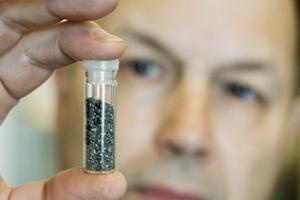Jul 22 2009
Researchers often make progress by applying a proven scientific method from one realm to another, connecting seemingly disparate disciplines. Such interdisciplinary approaches are powerful tools in the drive for scientific innovation.
 Prof. Scott Dunbar is enlisting the help of viruses and bacteria in copper mining. (Credit: Photo by Martin Dee)
Prof. Scott Dunbar is enlisting the help of viruses and bacteria in copper mining. (Credit: Photo by Martin Dee)
But who would ever dream of applying viruses to mining? Professor Scott Dunbar of UBC's Norman B. Keevil Institute of Mining Engineering would.
"I read an article about bacteriophage - viruses that infect bacteria - being used to create nanodevices in which proteins on the phage surface are engineered to bind to gold and zinc sulfide," says Dunbar. "And it struck me: if zinc sulfide, why not copper sulfide? And if so, then it might be possible to use these bio-engineered proteins to separate common economic sulfide minerals from waste during mineral extraction."
Bacteriophage, commonly called phage, refers to viruses that infect bacteria. Typically phage consists of an outer protein coating that enclose genetic material-DNA. They are the most abundant life form on Earth, numbering as many as 1031. Phage replicate by infecting bacteria but are harmless to humans, animals and plants. Only a few nanometers in diameter, hundreds could fill the diameter of a single human hair.
Current methods of sulfide mineral separation add detergent-like chemicals called collectors to a tank containing a slurry of finely ground ore particles. Collectors render specific sulfide particles in the ore hydrophobic ("afraid" of water) so that they attach to bubbles in the tank and float to the surface forming a sulfide concentrate. However, in some cases, particularly with ores that contain several sulfide minerals, the recovery of specific sulfide minerals can be poor.
Dunbar has partnered with UBC colleagues Sue Curtis and Ross MacGillivray from the Centre for Blood Research and the Department of Biochemistry & Molecular Biology to bring the idea from concept to laboratory. Together they recently published a paper entitled Biomining with bacteriophage: Selectivity of displayed peptides for naturally occurring sphalerite and chalcopyrite in the journal Biotechnology and Bioengineering.
The researchers found that it is possible to identify proteins on bacteriophage that bind to minerals of economic interest such as sphalerite (zinc sulfide), the chief ore mineral of zinc, and chalcopyrite (copper iron sulfide), the chief ore mineral of copper. The procedure is called "bio-panning," a type of genetic engineering.
"You begin with a phage library which may contain one billion phage particles, each with different protein sequences. A few of these have the binding protein of interest. When the entire library is exposed to the mineral of interest, these few will bind to the mineral," explains Dunbar. "You wash away the non-binding phage, then expose the binding phage to E. coli, which they infect and reproduce. The resulting phage would have DNA that contains the 'codes' for the binding proteins of interest. The procedure is repeated four or five times to amplify the number of binders. It's somewhat like breeding animals for particular features.
"I knew we had phage that could bind specifically to sphalerite and to chalcopyrite," says Dunbar. "But then, so what? The phage had to do something to the mineral surfaces to be useful."
It turns out that the phage that bind to a mineral do affect the mineral surfaces, causing them to have a different electrical charge than other minerals. The proteins on the phage also form links to each other leading to aggregation of the specific sulfide particles. "The physical and chemical changes caused by phage may be the basis for a highly selective method of mineral separation with better recovery. Another possible application is bioremediation, where metals are removed from contaminated water" says Dunbar.
Dunbar and his colleagues are the first to apply phage to mineral processing. Their work is supported in part by the Applied Research and Technology group of Teck Corporation and the Michael Smith Foundation for Health Research. Prof. Valery Petrenko of Auburn University supplied a phage library.